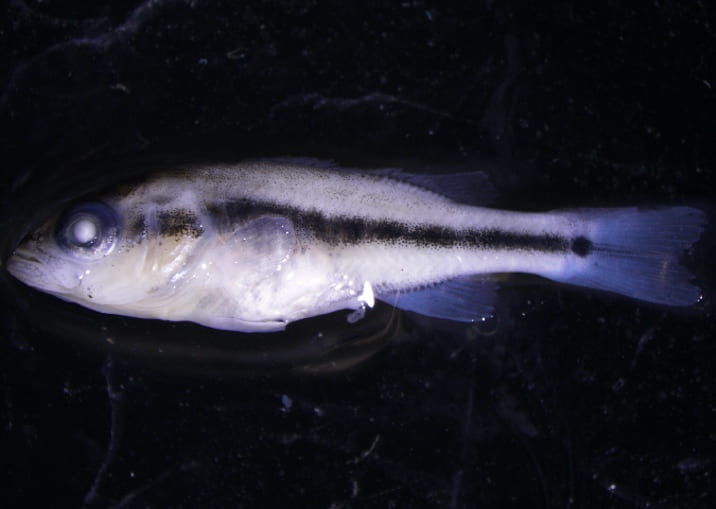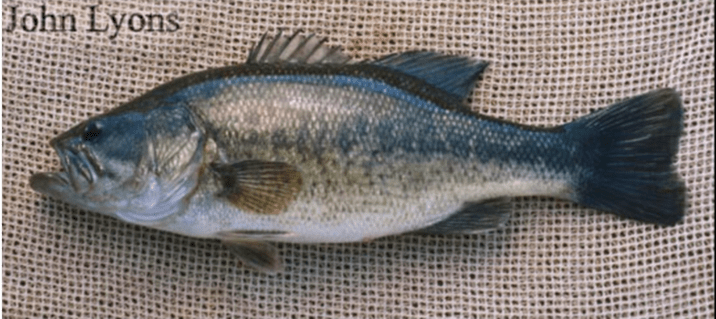Key Characteristics:
- Roughly equal number pre and post-anal myomeres.
- Fewer total myomeres than Percidae (less than 35).
- Double dorsal fin, but this may not be visible until they are older.
- Dorsal and anal fins across from each other.
- As they age, become deep bodied
- Can have many or few melanophores.
- Heavily pigmented
- Robust body, large head

Larval Largemouth Bass. 19 mm. United States Fish Wildlife Service. Green Bay, WI. Adam Dziewa. 2018.

Juvenile Largemouth Bass. 39 mm. United States Fish Wildlife Service. Green Bay, WI. Adam Dziewa. 2018.
- Body not elongated, eel-shaped, round in transverse section, uniformly pigmented (1B)
- Chin barbels absent (3B)
- Snout short, its length usually less than 10% TL; median fins otherwise (5B)
- Median fins or finfolds showing distinct separation (7B)
- No adipose fin, or demarcation of one, in finfold (10B)
- Preanal myomeres greater than or equal to postanal myomeres (14A)
- Preanal myomeres approximately equal to postanal myomeres (difference five myomeres or less) (15A)
- Total myomeres less than 35 (20B)
- Total myomeres between 26 and 34 (21B)
- Adipose fin or its position absent (23B)
- Double Dorsal Fin (24A)
- (Centrarchidae)
Adult History (1, 2, 3, 6, & UW – SG)
- Physical Description
- Terminal mouth extends beyond non-red eye, lower jaw extends to rear margin of eye, small teeth, big notch between the 2 dorsal fins (first fin: 10 spines & second fin: 12-14 rays), dark stripe along the side of body, dark green sides and back, 60-68 ctenoid lateral scales, and an anal fin with 3 spines and 10-12 rays
- Spawning Habitat
- Shallow and sheltered areas of rivers, ponds, and lakes
- Aquatic vegetation
- Below 2 meters deep
- Shallow and sheltered areas of rivers, ponds, and lakes
- Spawning Substrate
- Eggs are deposited on the sand, gravel, or soft mud
- Eggs attach to rocks or aquatic vegetation
- Spawning Behavior
- Polygynandry Behavior
- Males build and guard their nests
- Males will continue to defend broods for a short time period (1-2 months)
- Females don’t invest any time in nest building or parental care
- Males reach sexual maturity – 3-4 months/females: 4-5 months
- Time of Year
- April – June in Lake Michigan
- Spawning typically takes place at water temperatures of 60 – 75°F
- Diet
- Omnivore
- Small fish, frogs, crayfish, insects, leeches

